Detective fiction is a subgenre of crime fiction and mystery fiction in which an investigator or a detective—either professional, amateur or retired—investigates a crime, often murder. The detective genre began around the same time as speculative fiction and other genre fiction in the mid-nineteenth century and has remained extremely popular, particularly in novels. Some of the most famous heroes of detective fiction include C. Auguste Dupin, Sherlock Holmes, and Hercule Poirot. Juvenile stories featuring The Hardy Boys, Nancy Drew, and The Boxcar Children have also remained in print for several decades.

A whodunit or whodunnit is a complex, plot-driven variety of a detective story in which the puzzle regarding who committed the crime is the main focus. The reader or viewer is provided with the clues from which the identity of the perpetrator may be deduced before the story provides the revelation itself at its climax. The investigation is usually conducted by an eccentric, amateur, or semi-professional detective. This narrative development has been seen as a form of comedy in which order is restored to a threatened social calm.

Crime fiction, detective story, murder mystery, mystery novel, and police novel are terms used to describe narratives that centre on criminal acts and especially on the investigation, either by an amateur or a professional detective, of a serious crime, generally a murder. It is usually distinguished from mainstream fiction and other genres such as historical fiction or science fiction, but the boundaries are indistinct. Crime fiction has multiple sub-genres, including detective fiction, courtroom drama, hard-boiled fiction, and legal thrillers. Most crime drama focuses on crime investigation and does not feature the court room. Suspense and mystery are key elements that are nearly ubiquitous to the genre.

John Dickson Carr was an American author of detective stories, who also published using the pseudonyms Carter Dickson, Carr Dickson, and Roger Fairbairn.
The "locked-room" or "impossible crime" mystery is a subgenre of detective fiction in which a crime is committed in circumstances under which it was seemingly impossible for the perpetrator to commit the crime or evade detection in the course of getting in and out of the crime scene. The crime in question typically involves a crime scene with no indication as to how the intruder could have entered or left, for example: a locked room. Following other conventions of classic detective fiction, the reader is normally presented with the puzzle and all of the clues, and is encouraged to solve the mystery before the solution is revealed in a dramatic climax.
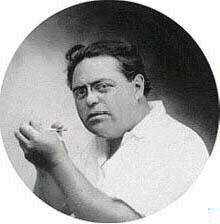
Jacques Heath Futrelle was an American journalist and mystery writer. He is best known for writing short detective stories featuring Professor Augustus S. F. X. Van Dusen, also known as "The Thinking Machine" for his use of logic. He died in the sinking of the RMS Titanic.
Crime is a typically 19th-, 20th- and 21st-century genre, dominated by British and American writers. This article explores its historical development as a genre.
Clayton Rawson was an American mystery writer, editor, and amateur magician. His four novels frequently invoke his great knowledge of stage magic and feature as their fictional detective The Great Merlini, a professional magician who runs a shop selling magic supplies. He also wrote four short stories in 1940 about a stage magician named Don Diavolo, who appears as a minor character in one of the novels featuring The Great Merlini. "Don Diavolo is a magician who perfects his tricks in a Greenwich Village basement where he is frequently visited by the harried Inspector Church of Homicide, either to arrest the Don for an impossible crime or to ask him to solve it."

Death from a Top Hat (1938) is a locked-room mystery novel written by Clayton Rawson. It is the first of four mysteries featuring The Great Merlini, a stage magician and Rawson's favorite protagonist.

The Mystery of the Yellow Room is a mystery novel written by French author Gaston Leroux. One of the first locked-room mystery novels, it was first published serially in France in the periodical L'Illustration from September 1907 to November 1907, then in its own right in 1908.

Dr Gideon Fell is a fictional character created by John Dickson Carr. He is the protagonist of 23 mystery novels from 1933 through 1967, as well as a few short stories. Carr was an American who lived most of his adult life in England; Dr. Fell is an Englishman who lives in the London suburbs.
Edward Dentinger Hoch was an American writer of detective fiction. Although he wrote several novels, he was primarily known for his vast output of over 950 short stories.
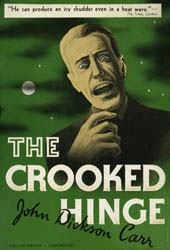
The Crooked Hinge is a mystery novel (1938) by detective novelist John Dickson Carr. It combines a seemingly impossible throat-slashing with elements of witchcraft, an automaton modelled on Maelzel's Chess Player, and the story of the Tichborne Claimant. It was dedicated to fellow author Dorothy Sayers "in friendship and esteem."

The Adventure of the Christmas Pudding and a Selection of Entrées is a short story collection written by Agatha Christie and first published in the UK by the Collins Crime Club on 24 October 1960. It is the only Christie first edition published in the UK that contains stories with both Hercule Poirot and Miss Marple, the writer's two most famous detectives. It retailed in the UK for twelve shillings and sixpence (12/6) and comprises six cases. It was not published in the US although the stories it contains were published in other volumes there.
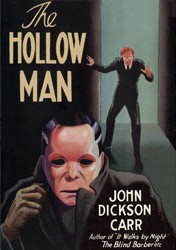
The Hollow Man is a 1935 locked room mystery novel set in London by the American writer John Dickson Carr, and featuring his recurring investigator Gideon Fell. It contains in chapter 17 the often-reprinted "locked room lecture" in which Dr Fell speaks directly to the reader, setting out the various ways in which murder can be committed in an apparently locked room or otherwise impossible situation.
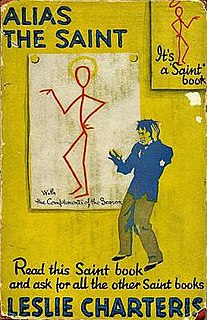
Alias the Saint is a collection of three mystery novellas by Leslie Charteris, first published in the United Kingdom in May 1931 by Hodder and Stoughton. This was the sixth book to feature the adventures of Simon Templar, also known as "The Saint". The three stories had previously been published in The Thriller magazine in the UK.
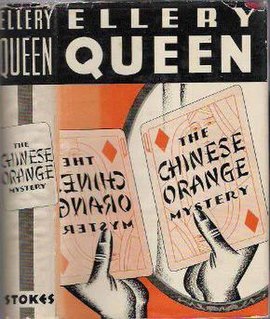
The Chinese Orange Mystery is a novel that was written in 1934 by Ellery Queen. It is the eighth of the Ellery Queen mysteries.

The Plague Court Murders is a mystery novel by the American writer John Dickson Carr, who wrote it under the name of Carter Dickson. The first Sir Henry Merrivale mystery, it is a locked room mystery of the subtype known as an "impossible crime".

The Dead Man's Knock, first published in 1958, is a detective story by John Dickson Carr which features Carr's series detective Gideon Fell. This novel is a mystery of the type known as a locked room mystery.
Hake Talbot is a pen name of the American writer Henning Nelms (1900-1986). Talbot was chiefly known for his impossible crime, locked room mystery novel Rim of the Pit (1944). Nelms reserved his real name for writing non-fiction about showmanship. He was the author of the book Magic and Showmanship: A Handbook for Conjurers (1969).












